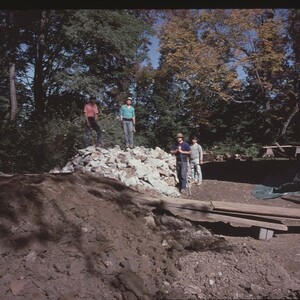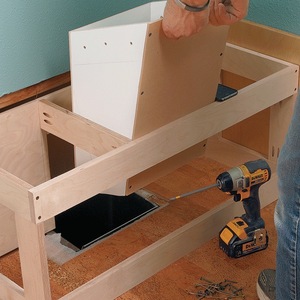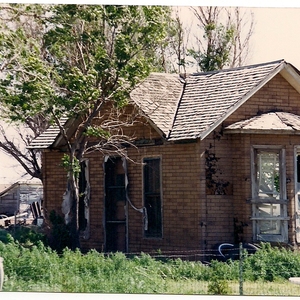Freeze proofing underground water pipe
We have a 3/4″ water line feed from the main house (I call it the “big” house) to what was the carriage house. The carriage house is now a 3 car garage with a 1 bedroom apt on the second floor.
The problem is that the water feed is leaking, probably from freezing and splitting. The pipe is deep enough, but it runs right beside the exterior basement steps, probably about 6″ in.
Besides the water pipe, there is a gas pipe from the big house to the carriage house, and an underground electric feed from the alley to the big house. Plus there are the basement steps, a back door, and a concrete patio.
If I move the water supply pipe to a point that will ensure 42″ of dirt coverage all around it, I’ll have to go through new plantings, and the electrical feed, and probably past the gas feed.
Is there some way to provide heat or otherwise ensure no freezing if I keep the pipe in the current location? I’m thinking about starting at the carriage house and working my way backwards to the house until I find the point it transitions from copper to galvanized, and then pulling new copper, hopefully being able to tunnel underneath that portion of the patio. This route avoids both the gas and the electrical, but cannot be far enough away from the basement steps.


















Replies
Dirt is no more than a poor insulator. It only advantage is that comes cheap in bulk form and that there is a "heat source" under it.
Strips of styrofoam above and towards the stairs wall shoudl do the job.
You don't want to insulate under it.
Do not bury the line in "dirt", the line should be buried in sand then put top soil for the top 6 to 8 inches. You should also have 8" of sand underneath the pipe. Sand does not hold moisture so it will not freeze solid like dirt or regular soil will. I'm up in Mass and we just replaced our water line last year because it developed leaks. We had cement lined galv pipe and replaced it with 1" ABX pex tubing. The pex should also help protect from the frost because it will move some while the galv or copper are more rigid.
The leak is most likely at the transition from copper to galvanized, if there is not a dielectric fitting for the transition.
If your frost depth is 42" and you footing for the steps and water line are at 42", it may not have frozen beside the steps. simple test is probe with a rod beside the test to 42 ' depth. Turn on the water. If it fills up the probe holes quickly, it is there. If not, then it is further down stream.
How does the old galv. go into the house? If it is in direct contact with a concrete wall or block, it can fail there also, but you would likely see it in the form of a wet crawl space, or leak in a basement wall. 6" is a little close for me for galvanized or copper pipe next to concrete. I would sleave any copper repacement pipe or use polyethelene or pex within a few feet of it, just to reduce any galvanic reactions that could occure between the concrete, soil, and pipe.
Let us know what your dig reveals please. What you learn will add to all of our knowledge.
Dave
You know, I hadn't thought about the possibility of a leak at the joint. I do know that the leak is near the house because I can hear water run in the storm drain system for the gutters if I turn the water on. I'm not sure exactly where the galvinized to copper transition occurs, only that it is copper at the carriage house and galvinized exiting the big house.What I really want to know, is how did the home inspector, the plumber we paid to inspect the plumbing, the plumbers that replaced the remaining galvinized pipe in the house ALL miss this. You can hear it run as soon as you turn on the valve. But maybe it didn't leak then. I've got to go back to water bills and see when it appears to have started.It will be awhile before I do anything. Just trying to figure out what my best option is.
Oh, and unfortunately the patio extends to the side of the steps - the same side as the pipe is currently on. So no test holes there.I like the PEX idea. I'm hoping I can pull a replacement under the patio, but I don't know if I could get any styrofoam in there. Hence the question about heating the pipeMaybe I should run HOT water out to the carriage house, with a recirculating loop. And then I could have a hot water COOLER to deliver cold water. hmmmm.....
If you can get several inches (minimum 2") of foam between the pipe and the steps, and, while you're at it, several more on top, you should have no problem. Have the foam extend about 18" below the pipe on the step side, and a similar distance beyond the pipe on the top side. Be careful to NOT put foam under the pipe -- you want heat rising out of the ground to reach it.
I would dig at the edge of the patio first. That one hole will give you the most information with the least effort. If you find galvanized there, do a binary search across the yard for the transition. If you find copper, you know you're going to have to tear up the patio. But deep down in your heart you probably already know that anyway.
The patio isn't too wide at the point in question, though I'm not sure about the walls/footings for the steps. So I'm hoping to tunnel underneath. But yeah, I wouldn't be surprised if I'm not cutting through the patio.
You know your plumber didn't tunnel under the patio, don't you?
I agree with Uncle Dunc, you'll likely find the transition from copper to galv. right there.
Cut the copper, cap it, and turn the water back on. If there is no running water sound when you turn it back on, the leak is not under the patio.
If it does leak---start tunneling, or saw cut a section out of the patio and break it out. The second is no more difficult IMO than the tunneling, and it is easier to work on the pipe. The tunnelled area under a poured patio is more than likely going to cause it to break, because it will become an area of uncompacted fill beneath the slab. With a 42" frost depth, you can expect it next winter at the latest.
Dave
Dave
And if you dig up under the patio, be sure to compact the new fill well, at least with a hand compactor, if not with JJ or vibrator. Otherwise you'll get subsidence in a few years.
>>You know your plumber didn't tunnel under the patio, don't you?The patio is not original, but I imagine it was in place whenever the water line got changed. It isn't so long that I wouldn't think it would be impossible to pull the line through from the outside under the patio and into the basement, but as you say, it certainly doesn't appear that way. Of course the problem with uncompacted fill would still be there.I like the idea of pulling the spliter through with PEX. I'm going to look for someone who can do that.
Outfits that install water mains have a device that can pull a new line right through an old line. They thread a cable through the old line, then pull a 'splitter' through to open up the metal pipe, and thread new polyethylene or PEX right through.
These materials will not burst if they freeze, except at a joint.
If you ran 2 pipes, you could certainly recirculate the water to keep it from freezing. You wouldn't even need to use hot water, since only some short sections are cold enough to be bothered. That, plus moving water does not freeze as easily.